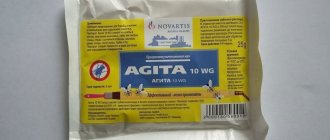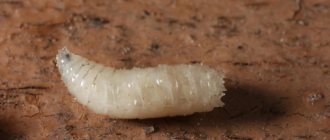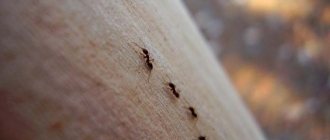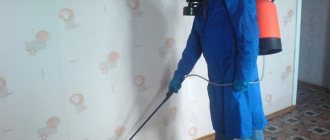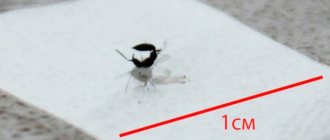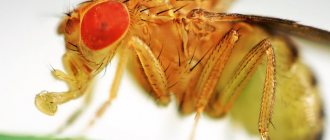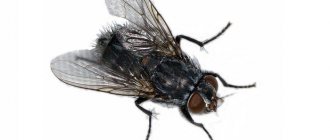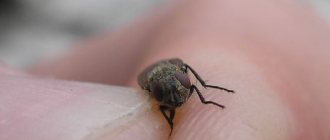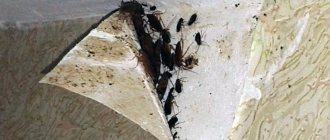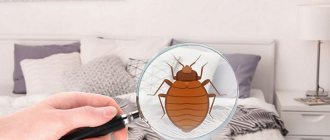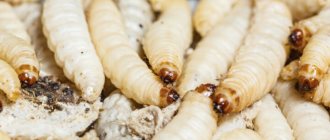- A brief excursion into biology
- Stages of development
- Features of green flies
- Harm and benefits of green flies
- Fighting blowflies Ways flies get into human housing
- Preventative measures against green flies
- Ways to combat carrions
Green flies are associated with carrion, which is justified. These insects with shiny bodies fly away as soon as a food object appears nearby. Larvae hatching from eggs speed up decomposition. They love street markets for meat, fish, sweets or other food products.
Large green flies are found on damaged fruits and berries in orchards and vineyards. There are especially many of them where there is excrement or meat (cesspools, slaughterhouses).
Where do flies come from in an apartment?
Several types of flies live in a person's home.
They are similar in appearance, lead a similar lifestyle, so the owner does not even think about their differences. With the onset of warm weather, apartments are colonized by house flies, which are not adapted to live in the wild; by the end of summer, biting flies appear; at any time during the warm season, a blowfly of a gray color or with a beautiful green or blue tint can enter the room. Flies appear indoors on their own or are brought in by people without knowing it. Adults crawl through small cracks in the wall, window sills, and ventilation shafts. They climb in through doors that are not tightly closed, if there are flaws in the mosquito net. And even if the house or apartment is completely sealed, all precautions are taken, parasites may end up in the room.
They are introduced by humans themselves at the stage of eggs and larvae. Females lay eggs on ripe or rotten vegetables, fruits, plants, and flowers. Green flies in an apartment or house appear due to stale meat and fish, since it is there that a new generation of pests begins to develop.
Interesting!
In winter, flies may appear in the house in a warm room. Their presence at this time of year is even more puzzling, since there is nowhere to come from. With the onset of cold weather, insects climb into cracks, fall asleep, and remain invisible to humans. On warm winter days, when the sun shines well through the windows and a comfortable temperature remains inside the building, they wake up. However, such wakefulness does not last long. The insects are either killed or they hide again.
in spring
Many summer residents, making their first test forays outside the city in the spring, are perplexed as to where the flies came from in a house locked for the winter. Most often, the cause of insects is eggs or larvae that were laid in the fall and overwintered somewhere in the bowels of the house. With the arrival of spring, the temperature began to rise, the development of insects resumed, and now the owners of the dacha are greeted by several young flies with the discordant buzzing.
Another explanation for the fact that flies appeared in a house or apartment in the spring is that they spent the winter in a secluded place, and now they have woken up. This option is also possible - the early spring was very warm and a new generation of flies was born, then the cold returned and the insects entered warm human habitation in search of warmth.
In summer
Where flies come from in the house in the summer is clear to everyone. It is during the warm season that insects are most active. There is simply an infestation of flies in houses and apartments. Most often they fly into rooms through windows that are open for ventilation. Residents of houses whose windows overlook garbage dumps and garbage cans suffer the most.
But even with the windows closed, getting into the room is not a problem for flies. Any small opening for her is a hospitably open gate. And if we are talking about a wooden house, in which there are always cracks and cracks, then insects penetrate there with ease. There are always more flies in the country. After all, nearby there is a plot with flowers, fruit trees, beds, compost heaps, often cesspools or street toilets.
In addition, buildings for keeping animals are often located next to private houses. In cowsheds, chicken coops, and pigsties there are always a lot of flies that periodically fly into the house.
You can even bring flies with a bouquet of wild or garden flowers, and eggs or larvae can be found on vegetables and fruits collected from the garden or purchased at the market.
in autumn
In autumn, the appearance of flies in the apartment does not stop. With the onset of cold weather, insects gather in groups and look for a warm place to winter. They climb into cracks, hide between window panes, and find other hard-to-reach places where they hibernate.
In a country house in the fall, there are sometimes even more flies than in the summer. Perhaps this impression is due to the fact that autumn flies are more lethargic, slower and catch your eye more often.
in winter
Flies can unexpectedly appear in the house in winter. Of course, they don't fly in from the street. Most often, this is a fly that accidentally woke up and was affected by too high a temperature in the room. Or perhaps the insects' hiding place was discovered and they were disturbed. Another option is that flies entered from the basement of the house through the sewage system or ventilation. You can bring larvae or eggs, for example, with purchased low-quality soil for indoor plants or with stale food.
Families and species
Dipterologists today distinguish the following groups:
Calliphoridae (Carrion)
- Calliphora vicina (blue redhead).
- Calliphora uralensis (blue meat).
- Lucilia sericata Mg. and Lucilia illustris Mg. (species of the genus green blowfly).
Area – Russia, Wed. Asia, Caucasus, Europe, North. America. The larvae of some species develop in carrion and cattle burial grounds no more than 1 meter deep, while others develop in cesspools. Adults feed on meat waste, feces, and fruits. You can meet them at bazaars and slaughterhouses.
Piophilidae (Cheese)
Scientists name about 100 species. Distributed everywhere, especially in areas where fishing is carried out. Fish, cheese, lard are the best places for the development of larvae, which grow up to 8 millimeters. If disturbed, they can jump up to 150mm.
Hippoboscidae (Bloodsuckers)
They live everywhere. There are about 800 species. Adult flies are blood-sucking. With paws equipped with serrated claws, they cling to birds, deer, dogs and other animals. Sometimes they attack people, causing skin inflammation.
Sarcophagidae (Grey meats)
Distribution: Europe, Asia, North Africa. There are approximately 3 thousand species. It reproduces on corpses, feces, manure, and food waste. Adult flies eat feces, meat, and fruits.
One of the most dangerous representatives of the family is the Wohlfart fly. She lays larvae on open wounds. By eating living tissue, parasites cause severe pain.
Oestridae (Gadflies)
Pasture insects. Maggots develop on the body of livestock and humans.
- Hypodermatinae (Subcutaneous). Doesn't live only in the Far North. The larvae penetrate the skin into the body and move through the tissues, causing skin lesions.
- Gasterophilinae (Stomach). Lives everywhere. Larvae enter the gastrointestinal tract with food and lead to inflammation of the stomach.
- Oestrinae (Cavity, nasopharyngeal). The larvae enter the mucous membranes, and from there into the pharynx and frontal sinuses, leading to miasma.
Drosophilidae (Drosophila)
Distributed everywhere. Midges can be seen in flower pots and bird nests. There are 1.5 thousand species. They feed on rotting plants. Maggots develop in spoiled vegetables and fruits, compotes, juices: apple, cherry, grape.
The most famous type. There are more than 5 thousand species in the world. The most common in Russia are:
- market;
- autumn fireweed;
- Room, house.
Description
Adult L. sericata (top left) Macro view of head
Defining characteristic of L. sericata
and the most commonly used in identifying an adult fly is the presence of three setae on the dorsal part.
mesothorax, located in the middle of the back of the fly. L. sericata
is almost identical to its sister species,
L. cuprina,
and identification between them requires microscopic examination of two main distinguishing characteristics.
L. sericata
is blue-black, unlike
L. cuprin
, which has a metallic green hip joint in the first pair of legs.
Also when looking at the nuchal setae, L. sericata
has one to nine setae on each side, while
L. cuprina
has three or fewer.[2]
Reproduction in apartment conditions
Females lay eggs in rotten indoor plants, vegetables, fruits, food waste, and trash cans. Insects do not reproduce in a closed apartment as intensively as when the windows are open, but within 14 days an infestation of flies may be observed in the room.
Comfortable temperatures and unsanitary conditions contribute to high rates of reproduction. Garbage that is not thrown away for weeks, a bucket of slop, drawers where unwashed vegetables with soil particles are stored, unwashed dishes, an uncleaned table.
One female lays up to 150 eggs per day. The laying is repeated every 2 days. Within a week, the female establishes an entire colony. Under favorable development conditions, a larva appears the next day - maggot.
The size of the white worm does not exceed 1 mm, so it often goes unnoticed. Every day it increases in size, and after about 10 days of its existence it pupates. After 3 days, an adult individual emerges from the pupa, ready for fertilization. In this way, a lot of flies appear in a closed apartment within 2 weeks.
On a note!
A green, blue or gray blowfly indoors can also lay eggs. However, their development requires certain conditions. Maggots eat protein foods and develop in tissues where rotting and fermentation occur. If you leave a piece of meat for a week or two, or fish, a new generation of parasites will appear; under other circumstances, they die without going through the full development cycle. Only house flies can breed indoors.
The most common varieties
Gray
It has a large body 10–14 mm in length, with red eyes on its white-yellow head.
The head is divided in half by a black stripe; on the chest there are light stripes located longitudinally. The segmented abdomen of the gray blowfly has an oblong shape, the legs are very densely covered with short hairs.
Blue
The body reaches a length of 10–16 mm, has a blue color with a faint light coating.
The head is yellowish-red, shimmering with a golden sheen.
There are dark whiskers on the cheeks.
The breast is black with a bluish tint.
On the back are faint longitudinal black stripes.
Distributed in all forest regions of Russia.
Green
The body size is 5–10 mm in length.
The body color is green with a metallic sheen.
The abdomen has a faint coating of light shades.
The wings are transparent, the tentacles are yellowish, and the legs are black.
This species is very thermophilic and is found in central Russia only in hot summers.
It mainly lives in semi-desert, desert and steppe areas.
What attracts flies to our homes?
The smell of food and warmth are the main reasons that attract flies into homes. Insects have a unique sense of smell; they sense odors from afar, so they fly to apartments where they can profit from something. Flies can be attracted by:
- rotting vegetables, berries, fruits;
- spoiled meat, fish;
- waste in the trash can;
- leftover food on the table, dirty dishes;
- dirty, wet dish sponges;
- stale food in a pet's bowl;
- Stagnant water in trays from under indoor plants.
Flies in food
Also, a factor in the appearance of flies can be the pet’s bedding, which has not been changed for a long time. In the bedding of hamsters and guinea pigs, excrement and food debris accumulate, the smell of which is attractive to flies.
Risk factors
You may notice that in some apartments there are no flies at all, while in others there are countless numbers of these flying parasites. What attracts a fly besides warmth?
The answer is simple - the “aroma” of food waste. What flies love most is the smell of food starting to rot. In the trash bin, this smell is usually emitted by the skins and skins of vegetables and fruits. Discarded leftover meat and rotten food are also strong temptations for flies.
High humidity can also be the reason why flies prefer your apartment to others. Try reducing the humidity level by using an air conditioner, split system or heater.
Lepidoptera
Insects with complete transformation, examples of which we will now consider, are among the most beautiful representatives of the animal world. Their scientific name is associated with the structure of the wings, which are covered with scales. But everyone is accustomed to calling them butterflies, which in Orthodox translation means “old woman, grandmother.” This is due to the ancient belief that these insects are inhabited by the souls of the dead.
The salivary glands of butterfly caterpillars secrete a special substance from which threads are formed. From these, insects weave protective shells - cocoons or attach pupae to various objects. The threads of silkworms, which can reach 2 km in length, are used to produce natural fabrics.
Traditional methods
A favorite means of dealing with buzzing and annoying dipterans is an ordinary fly swatter or its harsh analogue - newspaper rolled up in several layers. However, other techniques are common among people to help get rid of annoying insects.
Fly tape
Velcro tape is not the most aesthetically pleasing, but very effective tool. It is sold in any hardware store and has an affordable price. All you have to do is buy it in the right quantity and hang it in crowded places.
The principle of operation is extremely simple: the aroma of the tape attracts the fly, it flies to it to feast on it or lay eggs. It lands on a surface lubricated with a special substance and sticks with its paws. Lack of food or sticking of the respiratory organs leads to the death of the insect.
Pros:
- low cost;
- efficiency;
Minuses:
- the need to watch the dangling fly corpses;
- may cause hair to be pulled out and snags on clothing; In large spaces it will not be possible to get by with Velcro alone.
Vacuum cleaner
Velcro tape comprehensively solves the problem with several dozen flies. But what to do when there are hundreds of them? This is a task for a powerful vacuum cleaner. Arm yourself with the device and treat those places where the greatest accumulation is: windows, window sills, cracks, etc.
Among the disadvantages of this method:
- inconvenience - the vacuum cleaner is heavy and not the most mobile, with it you will not be able to penetrate into secluded places where dipterans are hiding;
- high cost - not every home has a vacuum cleaner, and buying it only to fight flies is not the most sensible and rational decision.
Important! After treating the premises, the device bag must be immediately cleaned and washed so that insects do not have time to leave eggs in it.
Plants
An effective and environmentally friendly tool for combating buzzing dipterans is repellent plants or eater plants. The first include geranium, wormwood, walnut or tansy leaves, field daisies, as well as tomato tops - flies really don’t like their smell. The second one is the Venus flytrap. This is an amazing fly catching plant. Just place it in areas of greatest congestion and the problem will resolve itself.
Natural poisons
Some products that people actively use in cooking turn out to be destructive for flies. Therefore, they can be used in the fight against annoying dipterans and not worry about your own health.
What natural ingredients do insects hate?
- Ground black pepper. It is usually combined with something sweet - honey, jam or glucose syrup.
- Carnation. The spice kills flies - just spread it in crowded areas and after a couple of hours you will see that the home space is free.
- Garlic. It must be cleaned and crushed, scattered where dipterans fly.
As you can see, these are common foods that everyone has in their refrigerator.
Modern methods
Of course, life does not stand still. Methods of combating dangerous insects are constantly being improved and modernized. Below are more effective alternatives to home remedies.
Trap lamps
A more effective and functional analogue of the usual adhesive tape. They are mounted on the wall, have a stylish design and easily fit into the interior. The principle of operation is simple: the fly flies towards the light, but sticks to a trap placed in front of an ultraviolet emitter. In order for the insects to continue to die, it is necessary to periodically change the paper.
Insecticidal lamps
The principle of operation is the same here. The only difference is that dipterans do not stick to paper, but practically end up in the “electric chair”. It's all about the electrical grid through which current is passed. The fly flies towards the light, but eventually dies from the discharge.
Important! A person can take hold of this lattice. For him, the discharge discharge is safe.
Electric fly swatters
This device is ideal for those who like to be on the move. In appearance it resembles a badminton racket, but the plastic base is replaced with a metal one. The fly is shocked by the electric charge.
Electric fumigators
The principle of the device is extremely simple: after connecting to the network, the device begins to evaporate the composition of the tablet, which is toxic to insects. It is effective, but has a significant disadvantage - it is not suitable for large rooms. The optimal area of premises is up to 12 square meters.
Fly traps
A fly trap is an effective and visual tool. You can make such a mechanism yourself, but stores also offer a wide range of parasite traps. The simplest homemade trap is made from a plastic bottle:
- Rinse the empty, unwanted plastic bottle with water and dry.
- Cut off the top of the bottle using scissors. Try to cut as evenly as possible - this affects the quality of the trap.
- Turn the cut top over and insert it into the bottle.
- Secure the result. Connect the two parts with tape or a stapler.
- Prepare the syrup. To do this, boil one glass of water in a saucepan and add half a glass of sugar. When the sugar dissolves, cool the resulting syrup.
- Carefully pour the syrup into the bottle. Additionally, lubricate the edges of the trap with it. You can also add other baits to the syrup: small pieces of fruit, such as apples. Meat that has begun to rot is also perfect. Fill the trap so that there is a little less than a centimeter left to the neck of the bottle.
- Place the trap in a warm and open place. A well-heated window sill is best.
Purchased traps come in a variety of shapes and prices. The cheapest ones cost about 300 rubles, while prices for the most expensive ones can be above 8,000 rubles.
spring-cleaning
This method involves eliminating the source of attraction for insects. In the kitchen, you need to wash the refrigerator, cabinet and other surfaces, clear the table, and wash the dishes.
To prevent pests from entering your apartment, store stale food in a separate sealed container, cover the trash can with food waste, and constantly treat the trash can with disinfectants.
Chemicals
Chemicals on the market are represented by the following main groups:
- sticky tapes. One of the most popular, simple and effective methods. Its main disadvantage is the deterioration of the aesthetics of housing. Velcro is a strip lubricated with a sticky substance with a sweet smell. The principle of operation is simple - the fly, attracted by the aroma, sits on the tape and sticks. After this, from lack of food (and sometimes due to sealing of the respiratory organs) it dies.
- fumigator. The operating principle of this device is to evaporate a toxic (only for flies, of course) composition of a tablet introduced into the body. Connects to the mains. The main disadvantage of the device is that it is not suitable for large rooms. It is best to use it in rooms up to 12 m2,
- aerosol. Sprays and aerosols are more suitable for protecting the area from parasite invasion. However, they are also suitable for preventing the appearance of flies and exterminating insects that have already appeared in the apartment. It is necessary to spray the spray over the area of the room. Flies cannot tolerate the active ingredients and suffocate or fly away. Nothing bad will happen to a person from the aerosol, however, such drugs should be used with caution for those suffering from asthma or allergic reactions,
- gel with poison. Gels with poison for flies are applied either to a special substrate, which is sold along with the product, or to the surfaces themselves with which flies most often come into contact. Insects are attracted by the aroma of the gel, but upon contact with it they receive a lethal dose of poison and die. As with previous drugs, this poison is absolutely safe for humans, but it is better to hide the gel pads from children.
A cool period has come and the flies have become uncomfortable living outside. You open the door a little and migrants instantly take over the house. If in the summer it was somehow tolerable, then by autumn it became unbearable. In practice, we still use adhesive tapes, but, you must admit, this is not a very effective method, and such a device does not look aesthetically pleasing in the middle of the hall on a chandelier, and every now and then someone sticks to it. Fumigators that plug into an outlet scare me, especially with a small child. And aerosols are not a solution at all. At that moment, when the flies had already completely overcome, we decided to look for a remedy that would suit us all, but really did not suit these insects. And you know, we found it. The gel [Mukhoyar Fly Gel] is applied to a substrate (we press it onto jar lids) and hidden, for example, behind a vase on a cabinet, on a window sill behind a flower pot, on a kitchen unit. So they don't spoil the view. And the child will not get into the product. Moreover, flies do not stick to the gel. The gel has no odor. It does not release hazardous substances into the air, so it is absolutely safe to use it even in the presence of children. But, of course, you shouldn’t touch it with your hands.
Using homemade traps
If for some reason a person cannot buy special sticky traps for flies, then you can make insect bait yourself using improvised means. First, make syrup (50-60 grams of sugar per 100 milliliters of water with the addition of lemon juice). Next, cut pieces of paper to the required length, spread with the prepared solution and leave to dry. A hole is made in the top of the trap for a loop.
After the syrup has dried, the strips are hung in places where flies are most concentrated. Another option for a homemade trap is to use a milk solution with the same sugar concentration. The liquid is simply poured into a jar, after which the containers are placed around the perimeter of the apartment.
Here's another way to make homemade fly traps.
Mechanical methods
Mechanical methods are simply killing flies with a fly swatter, newspaper, slipper or anything else that comes to hand. This method can only be effective if two or three parasites appear that have flown to you completely by accident. If there are about a dozen flies and they keep multiplying, then a fly swatter is not enough.
Professional pest control
If there are too many flies, you should consider the services of professionals. Fortunately, pest control has now become quite accessible. For an average of 1,500 rubles, professional services will rid your apartment of flies. As a rule, cold and hot fog generators are used for this, which destroys all parasites in the apartment. After this, the services can additionally treat the house to prevent the subsequent penetration of insects into your home.
When choosing a pest control service, rely on independent reviews. If possible, ask your neighbors and friends.
How to get rid of big flies
Fighting flies in a residential area To clean your own apartment or house from pests, you need to do a general cleaning, restore order, seal the cracks, hang an anti-mosquito net on the windows and doors. When bringing vegetables, fruits, and herbs into the house, immediately wash them under running water or pour boiling water over them. Keep the room clean, clear the table, take out the trash promptly, and wash the dishes. In the absence of favorable conditions, flies will not develop in a house or apartment.
If you have flies, you can get rid of them in several ways:
- Hang adhesive tape around the rooms, which is sold at any hardware store, even a grocery store.
- Create a draft in the house, they will be blown away by the wind.
- Carry out disinfestation. For baiting, preparations based on broad-spectrum insecticides are used, in the form of a spray, aerosol, or concentrated emulsion. The preparations destroy insects within 60 minutes and protect against re-infection for 14 to 60 days. You can use household insecticides like Raptor or Agita, but in this case, killing the flies will take longer.
- Poisonous baits are placed on the windowsills of houses and apartments. Poison is added to honey, jam, sugar, fruit juice, and meat.
- They make traps from boxes, plastic bottles, and sticky tape.
To prevent infection of your home or apartment, you need to maintain order, use a mosquito net, wash fruits and vegetables immediately after bringing them into the room. It is necessary to get rid of eggs and larvae before the emergence of adults.
Peculiarities of insect life in an apartment
The common (house) fly is a well-known parasite that is not picky about food. The insect spends almost its entire life where there is a lot of food and favorable conditions for reproduction. Swarms of flies are found near garbage cans, landfills, in open toilets, damp basements, etc.
Insects are very prolific. The main feature of their reproduction is the laying of eggs in hard-to-reach places. In 30 days of her life, one female can lay up to 600 eggs. One clutch includes 150 pieces. Within a week, maggots (larvae) hatch, and after 2 weeks the pupa turns into an adult, ready for fertilization and reproduction. The process lasts endlessly until the cold weather.
On a note!
For the development of maggots, soil or a rotting environment is required. In apartments, this could be a flower pot, a trash can, a box for storing vegetables, excrement in the toilet, or ordinary dirt. Parasites do not reproduce in an apartment as intensively as in natural conditions, but this amount is enough to annoy the residents of the house.
Danger to humans
Flies in the house not only bring discomfort and irritation with their presence and buzzing, but they are also dangerous due to the spread of pathogens, infections, and diseases. There are many types of flies that harm humans in different ways. Among them there are blood-sucking parasites, pests that destroy crops and harvests. The most common are house flies and green flies in apartments and houses.
Diseases, infections:
- diphtheria;
- cholera;
- worms;
- tuberculosis;
- anthrax;
- severe poisoning;
- intestinal infections;
- brucellosis;
- tularemia.
Having excellent charm, flies are able to smell food from afar, they are especially attracted to the aromas of decomposition products. An infestation of flies in an apartment is observed in the kitchen, where they come into contact with household products, human food, in toilets, and restrooms.
Symptoms of invasion
The severity of symptoms largely depends on the number of parasites; the more there are, the more acute the disease. The larvae infect the mucous membranes, penetrate deep into the tissues, and lead to significant damage to the oral cavity.
Main symptoms:
- itching caused by moving around the oral cavity;
- swelling of the mucous membranes, hyperemia;
- open wounds, ulcers, mucosal disorders;
- with significant damage to the gums - inability to chew normally, pain;
- swelling in the nasal passages, difficulty breathing, rhinitis and nasal congestion often develop;
- intoxication of the body caused by decay products, fatigue, malaise;
- allergic reactions to toxins.
With severe damage, a noticeable rise in temperature and a feverish state are possible. Many experience lip deformation and difficulty speaking due to tongue disorders. Pus is released from the oral cavity, and there is an unpleasant smell of rotting.
Preventive actions
Do not forget that flies are the main carriers of infectious diseases and pathogenic bacteria. When flying, insects very quickly spread dangerous particles. Particularly unfavorable is the appearance in the house of a green carrion fly, which lives both among flowering, strong-smelling plants and in dirty places: manure, various rotting waste, as well as on decomposing animal corpses.
Due to the fact that flies breed quite quickly, their penetration into the house is completely undesirable. To prevent their spread, you must follow simple rules:
- do not leave vegetables, fruits, meat, fish, sweets and other products in the open for a long time, since they are a favorable environment for the development of eggs;
- try to keep the house clean by promptly disposing of food and household waste;
- use mosquito nets: since flies appear in homes, usually flying into windows or doors;
If pests are still able to appear in the house, it is necessary to use folk and chemical means to destroy them.
Sources
- https://apest.ru/muhi/o-muhah/otkuda-berutsya-muhi/
- https://WikiParazit.ru/babochki-i-moshki/otkuda-doma-berutsya-muhi.html
- https://obnaruzhil.ru/muhi/kak-razmnozhayutsya-muxi.html
- https://comp-plus.ru/uborka/muhi-v-kvartire-otkuda-berutsya-i-kak-izbavitsya
- https://obnaruzhil.ru/moshka/otkuda-v-kvartire-muxi.html
- https://klopkan.ru/muhi/otkuda-berutsya-muhi-v-kvartire-ili-dome-kak-izbavitsya/
- https://TerraBlag.ru/raznoe/otkuda-berutsya-muhi-v-dome.html
- https://kursi-floristiki.ru/muhi/kak-razmnozhayutsya-v-dome.html
[collapse]
Hymenoptera
Orders of insects with complete transformation cannot be imagined without the social representatives Hymenoptera. First of all, these are honey bees and ants. They live in large groups, within which responsibilities are clearly distributed. Thus, a bee family consists of a queen (queen), male drones and numerous workers.
A similar picture is observed in anthills. These insects are real hard workers. By building their homes, they mix the soil, increase its porosity and enrich it with organic matter. Ants are also considered unsurpassed “strongmen”. These unique insects are capable of lifting approximately 25 times their own weight. This is possible due to the extreme contraction force of their muscles.
